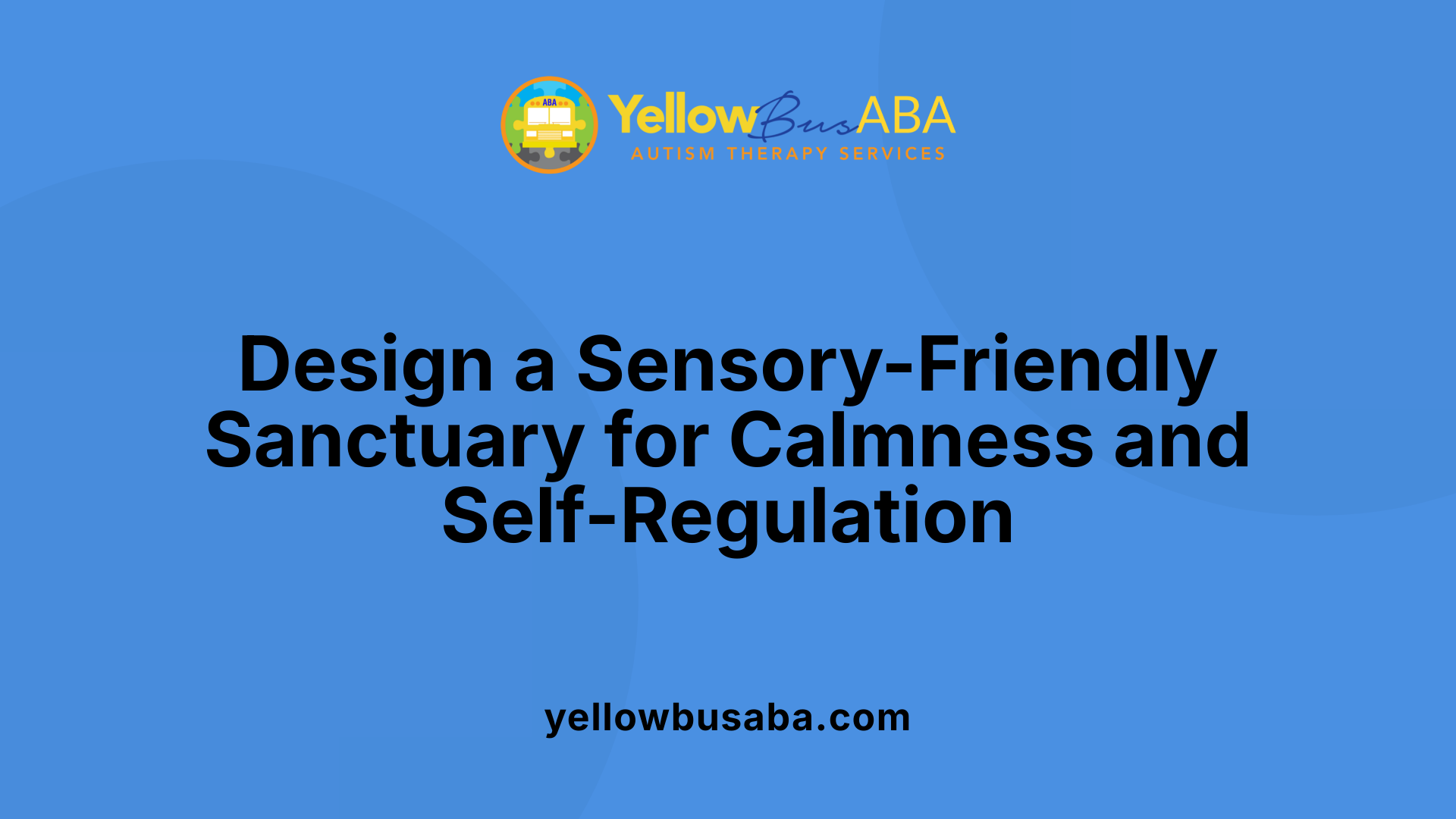How to Create an ABA-Friendly Environment at Home
July 15, 2025
Designing Your Home to Support Autism and ABA Therapy

Creating a supportive environment for children with autism at home
A well-designed home environment can significantly enhance the daily lives of children with autism by reducing stress, promoting independence, and supporting therapeutic strategies like Applied Behavior Analysis (ABA). Understanding sensory needs, establishing routines, and organizing space effectively are key to fostering a nurturing and functional living environment. This guide offers practical tips and detailed strategies to help parents and caregivers create an ABA-friendly home tailored to the individual needs of their child.
Establishing a Calm and Sensory-Friendly Space

How can I create an autism-friendly environment at home?
Creating a space that supports children with autism involves carefully designing areas that promote calmness and sensory regulation. Setting up a calming zone is essential; this should include soft lighting, comfortable seating, and soothing visuals that help children self-regulate their emotions.
In addition to a designated calming area, providing sensory tools and equipment can make a significant difference. Items like weighted blankets, fidget toys, and sensory bins stimulate and soothe sensory processing. Accessibility is important—organize these tools in labeled bins or shelves within easy reach, fostering independence.
Lighting plays a crucial role in reducing overstimulation. Using natural light and dimmable lights allows for control over brightness, creating a cozy environment. Controlling noise is equally vital; soundproofing, white noise machines, or noise-canceling headphones help decrease auditory overload.
Creating an autism-friendly home extends beyond sensory considerations. Implementing visual supports like schedules, picture cards, and clear labels helps children understand routines, reducing anxiety and promoting independent participation in daily activities.
Involving the child in choosing and setting up their environment promotes ownership and comfort. Collaborating with professionals, such as occupational therapists, ensures these spaces meet individual needs, fostering a safe, engaging, and peaceful environment for children with autism.
Organizing and Structuring Your Home Environment

What is the optimal home environment for a child with autism?
The best home setting for a child with autism is one that feels calm, predictable, and safe. It should include spaces free from chaos, with soft lighting, comfortable furniture, and sensory-friendly elements like weighted blankets or fidget toys. Consistent routines and visual schedules help children understand what to expect each day, reducing anxiety.
An organized home minimizes clutter, making it easier for children to focus and navigate safely. Using labeled storage bins and designated activity zones encourages independence and helps children locate their materials easily. The environment should also include designated calm spaces where kids can self-regulate if they feel overwhelmed.
Overall, a well-structured home offers sensory-friendly features and clear visual cues, creating a peaceful setting for children to learn, play, and relax.
Decluttering and Labeling
Removing unnecessary items and clutter creates a more manageable environment, lessening sensory overload.
Labeling storage bins and shelves with pictures or words helps children identify their belongings quickly, fostering independence.
This organization makes daily routines smoother and reduces stress for both children and caregivers.
Visual Schedules and Timers
Using visual schedules with pictures or icons guides children through daily activities, making routines predictable and less intimidating.
Timers or countdown clocks signal transitions, helping children prepare for upcoming changes and reducing meltdowns.
These tools improve understanding and give children a sense of control over their day.
Designated Activity Zones and Accessible Storage
Creating specific areas for homework, play, and relaxation helps children focus on tasks and enjoy quiet moments.
Accessible storage solutions, like low shelves and labeled bins, enable children to participate in cleanup and organization.
This setup promotes independence, responsibility, and a sense of ownership over their environment.
| Aspect | Implementation | Benefits |
|---|---|---|
| Decluttering | Regularly remove excess items | Reduces sensory overload, creates space |
| Labeling | Use visuals on storage | Fosters independence and easy access |
| Visual schedules | Incorporate pictures with routines | Enhances understanding and predictability |
| Activity zones | Designate specific areas | Encourages focus and organization |
| Accessible storage | Use low shelves and bins | Promotes self-help and responsibility |
Creating an organized home through decluttering, visual cues, and designated zones can profoundly impact a child's comfort and development. When children feel secure and understand their environment, they are more likely to thrive and enjoy their daily activities.
Implementing ABA Techniques in Daily Routines

How can I implement ABA therapy techniques at home?
Applying ABA (Applied Behavior Analysis) techniques in a home setting can greatly support a child's development. The process starts with establishing a predictable and structured environment. Consistent routines help children understand what to expect, reducing anxiety and promoting cooperation.
Positive reinforcement is a cornerstone of ABA. This involves rewarding desired behaviors with praise, small rewards, or preferred activities. Rewards should be immediate and meaningful to the child to strengthen learning and motivation.
Breaking down complex skills into small, manageable steps makes learning smoother. For example, teaching a child to wash hands can be divided into turning on the tap, applying soap, rubbing hands, rinsing, and drying each separately and then connecting them.
Incorporating strategies like Discrete Trial Training (DTT) and Naturalistic Teaching (NET) enhances skill acquisition.
Discrete Trial Training (DTT) involves clear, structured teaching moments where a specific skill is taught with a clear beginning and end, often using prompts and reinforcement. It is particularly effective for teaching new or complex skills.
Naturalistic Teaching (NET) encourages learning within everyday routines and activities. For instance, during play or meal times, you can model and prompt communication or social skills naturally.
Parents should use the ABCs of ABA—antecedent (what happens before), behavior (the action), and consequence (the result)—to understand and influence their child's behaviors.
Consistent data collection on behaviors and progress allows for adjustments in strategies, optimizing outcomes over time.
Collaboration with trained professionals like Board Certified Behavior Analysts (BCBAs) or Registered Behavior Technicians (RBTs) can guide proper implementation, ensuring techniques are adapted to each child's individual needs.
By integrating ABA strategies into everyday routines, parents turn daily activities into valuable teaching moments, fostering growth in a supportive and organized environment.
Enhancing Communication and Social Skills

How can visual supports and communication boards help children with autism?
Visual supports such as communication boards and picture cards are powerful tools for children with autism. They help make abstract language more concrete, allowing children to understand and express themselves more effectively. These tools can include images of common objects, emotions, or actions, arranged on boards or in booklets.
Using visual supports reduces frustration by providing clear cues about what is expected. For example, a child can point to pictures to request favorite foods, ask for break times, or greet family members. Consistent use of these visuals fosters better communication, helps children navigate daily routines, and supports independence.
How do Social Stories teach social skills?
Social Stories are personalized narratives that describe social situations and appropriate responses. They are designed to help children with autism understand social norms, expectations, and interactions.
For instance, a social story about greeting friends might include steps like saying hello, making eye contact, and waiting for a turn to speak. Repeating these stories helps children learn social cues and develop empathy. Visuals and simple language make these stories engaging and easier to grasp.
How to encourage verbal requests and social interactions?
Encouraging children to make verbal requests involves modeling appropriate language, prompting the child, and offering positive reinforcement when they attempt to communicate.
Turn everyday moments into learning opportunities—ask,
Supporting Emotional Regulation and Independence

Calm-down corners and sensory tools
Creating a calm-down corner in the home can be very effective for children with autism. This designated space, equipped with soft lighting, comfortable seating, and sensory items like fidgets or weighted blankets, provides a safe area for children to self-regulate when they feel overwhelmed. Sensory tools such as noise-canceling headphones, calming visuals, and sensory toys help children manage their feelings and promote relaxation. By offering a consistent space and sensory options, children learn to recognize their cues for stress and develop strategies to regulate their emotions.
Modified routines and adaptive tools
Establishing routines tailored to each child's needs offers structure and predictability, reducing anxiety. Using visual schedules and timers helps children understand what comes next, making transitions smoother. Adaptive tools like easy-grip utensils or communication devices support daily tasks and foster independence. Routine modifications, such as breaking down activities into smaller steps or incorporating preferred activities, can make daily chores and self-care tasks more accessible. These adjustments empower children to become more independent and confident in their abilities.
Encouraging everyday independence
Supporting independence involves giving children simple responsibilities, offering choices, and creating opportunities for decision-making. For example, allowing children to select their clothing or snacks encourages autonomy. Accessible play areas and organized storage help children initiate activities and develop life skills. Positive reinforcement, such as praise or small rewards, motivates children to try new tasks. Engaging children in setting up their environment boosts ownership and motivation, fostering a sense of control and confidence in daily routines.
Building a Comprehensive Supportive Home Environment
Creating an ABA-friendly home environment requires thoughtful planning and ongoing adjustment to meet the child's evolving needs. By establishing calming and sensory-friendly spaces, maintaining organized routines, and integrating ABA techniques into daily life, caregivers can foster independence, reduce stress, and improve social and communication skills. Collaborating with professionals and involving the child in setup decisions further enhances engagement and success. With patience and consistency, a supportive home can become a powerful catalyst for growth, learning, and overall well-being for children with autism.
References
- Creating an Autism-Friendly Home Environment
- How to Create an ABA-Friendly Home Environment
- Creating a Sensory-Friendly Home Environment for Children with ...
- How to Create an ABA-Friendly Home Environment for Your Child
- Incorporating ABA Therapy Activities into Daily Routines at Home
- Strategies for Autism Spectrum Disorder - Do2Learn
- Autism Support Strategies
- Home-Based ABA Therapy for Kids - ABATherapistJobs.com
- ABA Therapy at Home: All You Need to Know
- DIR/Floortime Therapy: A Comprehensive Guide for Parents and ...

.jpg)




